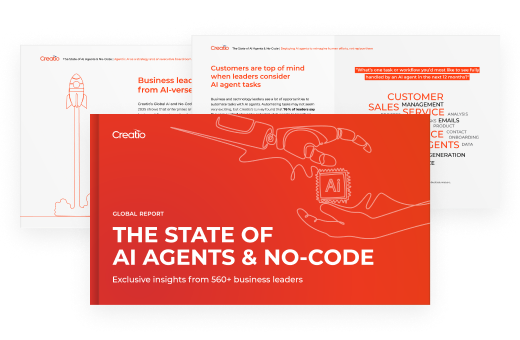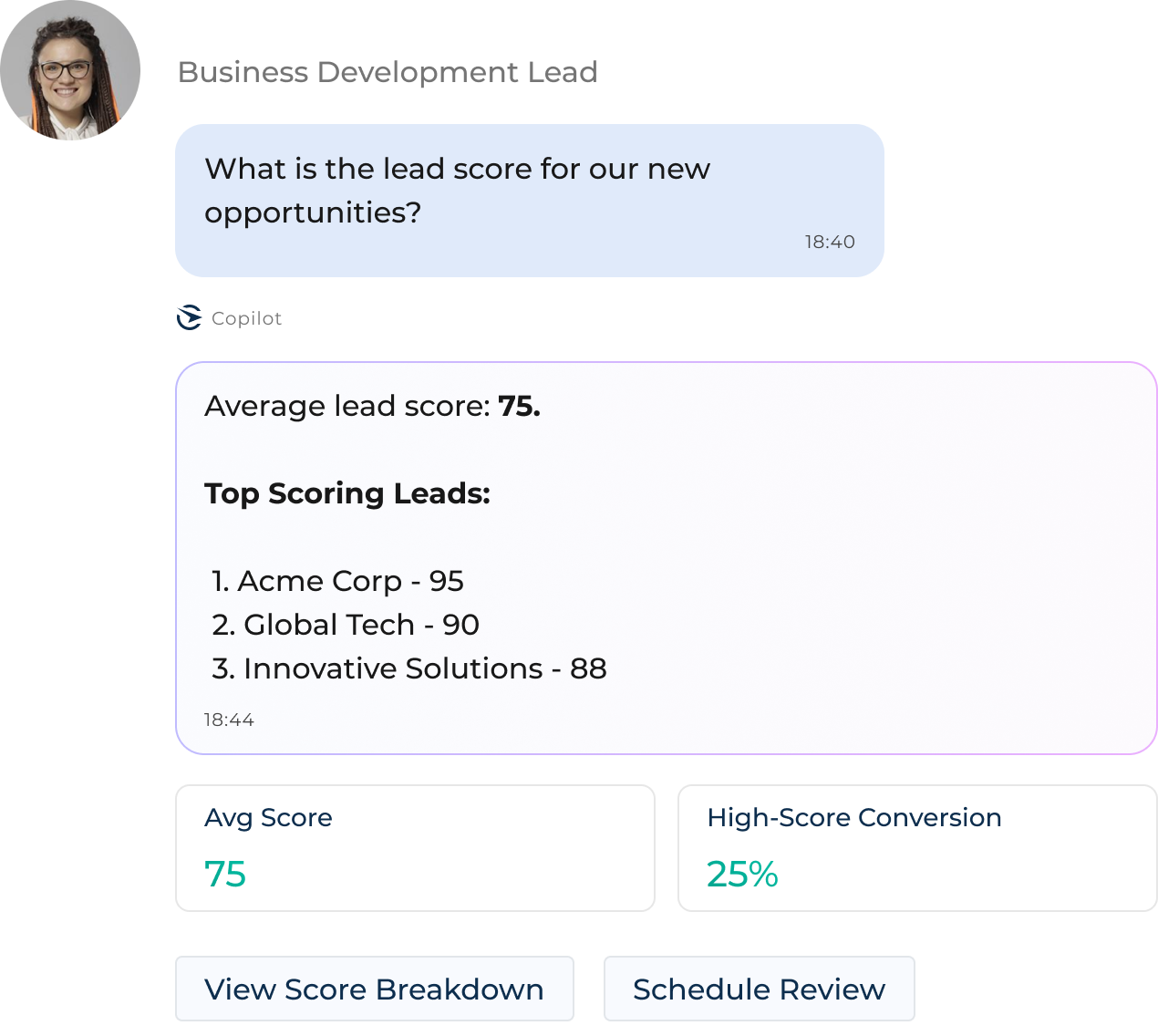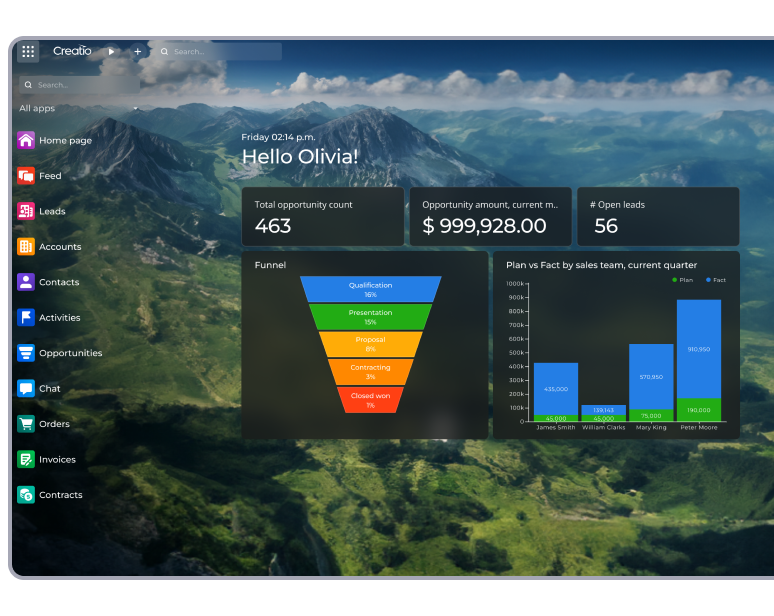-
No-Code
Platform
-
Studio
No-code agentic platform delivering the fastest time-to-value and the highest ROI
-
Studio
-
AI-Native CRM
CRM
-
AI-Native CRM
New era CRM to manage customer & operational workflows
CRM Products -
AI-Native CRM
- Industries
- Customers
- Partners
- About
What is AI Lead Scoring? How AI-Empowered Lead Scoring Increases Conversions
Updated on
October 14, 2024
8 min read
Identify High-Value Prospects With Unmatched Precision

Lead scoring is a crucial process that helps businesses identify and focus on the most promising leads, but traditional methods often lack precision and can overlook valuable data. With the rise of Artificial Intelligence, businesses gained a powerful new tool to enhance the accuracy of the lead scoring process. AI lead scoring boosts the precision of lead evaluation, identifying high-value prospects with greater accuracy and improving lead conversion rates.
In this article, we'll explore the key benefits of AI lead scoring and how businesses can implement it effectively to generate better leads and close more deals.
What is AI Lead Scoring?
AI lead scoring is a technology that applies a machine-learning algorithm to analyze customer engagement data, such as past interactions with the company, website behavior, demographics, engagement with marketing materials, etc. It then uses this data to predict which leads are more likely to convert into paying customers by assigning every lead a numeric score.
An AI lead scoring system determines the lead score using two types of criteria. First, it uses the baseline scoring criteria that’s initially set up by sales professionals in the form of “the ideal lead profile”. Then, it applies its own ongoing analysis of new lead data, history of customer interactions, conversion rate dynamics, market trends, etc.
For example, if visiting a pricing page on the company’s website starts to show particularly strong correlation with a higher conversion rate, the AI algorithm will give it more weight when calculating a total lead score.
For the analysis to be thorough and unbiased, the AI lead scoring system follows each lead on their entire journey, registering as much of the lead’s behavior as possible and gathering demographic and firmographic data from sources such as filled-out forms, social media platforms, etc. As more data about the lead becomes available, the system adjusts the lead score to ensure maximum precision. Once the lead score reaches a certain threshold number, the lead is flagged as a qualified prospect and can be prioritized for follow-up.
Example
For example, a lead with a senior job title scores 30 points. Another 30 are assigned when the lead downloaded a whitepaper that has proven to expedite customer buying decisions in the past. Finally, the system gives 40 points to this lead for visiting the pricing page and requesting a product catalog. This lead score 100 points, so it's time to hand it off to the sales team.
Some advanced AI lead scoring solutions, like the one offered by Creatio, also allow marketing and sales professionals to review the criteria and their weights assigned by AI to better understand the current impact of those criteria and make corrections if, for example, there’s a change in the businesses' target audience, strategy, etc.
The State of AI Agents & No-Code
Learn how 560+ leaders across the world use AI and no-code to drive innovation today

Difference Between Traditional and AI Lead Scoring
Traditional lead scoring is typically based on superficial criteria like company size, job title, or number of website visits. With this approach come certain issues.
First of all, the criteria are chosen by employees who can be prone to bias or error and often don’t take nuances into account.
For example, traditional lead scoring might miss subtle patterns in a lead’s behavior, such as the timing of interactions, the frequency of content engagement, how leads interact with different marketing channels, the influence of seasonality on buying behavior, and so on. These subtle yet important factors can indicate varying levels of interest and intent. So, if a potential customer diverts from the typical “ideal” journey, it can fall into a blindspot and, as a result, qualified leads can go unnoticed.
Second, the predefined rules used in traditional lead scoring can easily become obsolete and thus require constant review and reassessment. For example, if the market trends shift and a new category of products is suddenly very popular, traditional lead scoring is not going to automatically adjust its criteria to give more scores to prospects showing interest in these products. Instead, employees need to keep their finger on the pulse, constantly follow the trends, and manually adjust the criteria, which is time-consuming and often late in the day.
Third, using traditional lead scoring without automation means that leads have to be assessed manually, which can put significant pressure on your team’s productivity. Especially with a large pool of leads, manual lead scoring can cause delays and blockage in the pipeline. But even with an automated traditional lead scoring system in place, you still won’t have advanced analytical capabilities to discover deeper insights and to learn from new data on the fly, which come as standard with AI lead scoring solutions.
Traditional lead scoring | AI lead scoring | |
| Method | Manual scoring based on fixed rules; Simple rule-based automation | Automated scoring driven by machine learning, adapting to real-time data |
| Data analysis | Limited to small datasets with basic, surface-level analysis | Analyzes large, complex datasets, delivering comprehensive insights |
| Accuracy | Prone to human error, subjective biases, and outdated scoring criteria | Highly accurate, as it evolves with new data, though dependent on data quality and availability |
| Scalability | Difficult to scale; requires manual updates and adjustments | Automatically adapts to growing datasets and changes in lead behavior |
| Flexibility | Low flexibility; criteria are hard to modify, and adjustments are time-consuming | Highly flexible; constantly adapts to new patterns, customer behaviors, and market trends |
| Insights | Limited insights based on predefined criteria; lacks depth and broader context | Generates deep, actionable insights based on a data-driven approach |
| Efficiency | Time-consuming, manual activity | Fully automated and efficient process |
Benefits of AI Lead Scoring
AI lead scoring helps businesses select the most promising leads more accurately and efficiently. It improves lead conversion rates and allows organizations to acquire more, high-value customers.
Greater accuracy
AI lead scoring takes into account not only historical data but also continuously learns from the new information automatically obtained from such sources as email engagement, website activity, social media, industry reports, news analytics, etc.
This way, the scoring criteria are based on a broader range of factors, compared to traditional lead scoring methods, and can be constantly adapted to new client behavior and changing market conditions. This dynamic approach enables companies to stay competitive and responsive to market trends, ensuring that their sales strategies are keeping pace with the current customer needs and preferences.
Enhanced efficiency
Traditionally, lead scoring was done either manually, which took a significant amount of time and resources, or using simple systems that required frequent time-consuming adjustments to keep up with today’s fast-paced markets. However, with advanced technology like AI lead scoring, everything from analyzing data and adjusting scoring criteria to assessing and scoring leads is done automatically. This improves the efficiency of lead scoring and frees up employees' time to work on other tasks, such as lead generation and nurturing.
Unlimited pipeline capacity
More leads are always better. But what if you don’t have enough time and employees to evaluate them all? Your sales team might end up working with unqualified leads lowering their win rates. They might also miss on time-sensitive opportunities - leads are not going to sit idle for weeks and likely turn to more agile competitors.
With AI lead scoring, this problem disappears. Artificial intelligence technology can process a large amount of data in seconds, ensuring that no lead falls through the cracks, even if there are thousands of them.
Increased sales and revenue growth
Thanks to AI lead scoring capabilities to precisely identify the most promising leads, and adapt to changing conditions, sales reps can focus on the best opportunities as they arise. This helps them improve their conversion rates, win more deals, and increase the company’s revenue.
How to Implement AI Lead Scoring?
To ensure AI lead scoring system can provide accurate lead evaluation it needs to be set up properly.
Here are the key steps to implementing AI lead scoring:
1. Choose the right AI tool
Many CRM platforms and lead-scoring software offer built-in AI lead scoring capabilities. Choose a tool that fits your needs, whether it’s a standalone AI lead-scoring solution or an integrated feature within your CRM.
Make sure the AI lead scoring solution is transparent and provides access to review and modify its scoring algorithm. For example, Creatio CRM offers Creatio.ai, which not only does the lead scoring for you but can also explain why a certain lead got such a high or low score. This way you can better understand how the algorithm works.

Creatio.ai lead scoring
2. Define ideal lead
Describe an ideal lead for your business. Include such factors as demographic data (e.g., industry, company size) and behavioral data (e.g., website interactions, filled-out forms, email engagement, demo requests, etc). This will be the base for your AI model to set up its starting scoring criteria.
3. Integrate data sources
AI without data is like a car without fuel - it doesn’t matter how powerful the engine is if it doesn’t have the basic thing that allows it to move. AI lead scoring needs access to comprehensive data about your prospects and customers to accurately evaluate leads. You can achieve a seamless flow of valuable information by integrating various data sources such as CRM systems, marketing automation tools, website analytics, etc.
Make sure the data is cleaned and prepared before feeding it into the AI lead scoring system. Use the data cleaning features available in your CRM platform or data management tool or consider using specialized software designed to organize messy data. High-quality data is essential for accurate predictions, so removing duplicates, filling in missing values, and standardizing formats will significantly improve the system’s performance.
4. Train the AI model
Simply providing the data isn't enough for the AI model to work. AI algorithms need to be trained to provide the best results. To do this, feed your model with historical data, including past lead cases that resulted in conversion. Thanks to machine learning algorithms, the AI will analyze these examples, learn the characteristics of successful leads, and begin to create scoring models based on the most influential factors. Look for CRM solutions with no-code tools, such as Creatio CRM, to allow you to train your AI models effortlessly and without involving the IT team.
5. Train your team
Sales and marketing teams need to understand how to use AI lead scoring to seize its advantages. Conduct training sessions to ensure team members know how to interpret the lead scoring results, use them in their decision-making processes, and adjust their strategies.
6. Test and refine
AI models are not perfect right out of the box, so don’t forget to test them and improve if necessary. Run a test to evaluate how well the AI lead scoring matches your ideal lead profile. Gather feedback from sales and marketing professionals to adjust the scoring criteria and their weights.
Boost Your Revenue with AI Lead Scoring Integrated with a CRM
Investing in an AI lead scoring system integrated with a CRM can significantly enhance your sales strategy. By leveraging advanced algorithms and integrating with lead data sources, you can identify and prioritize high-potential leads more effectively, ensuring your sales team focuses on the most promising opportunities. This empowers your sales reps to improve conversion rates, close more deals, and ultimately boost your revenue.






















































